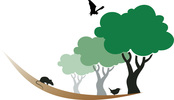Trees Outside Woodlands (ToW) are the hedges, individual trees and small groups of trees typically found in agricultural land. These features are potentially used as corridors and stepping-stones for species that could colonise young woodlands and are generally considered to be of high biodiversity value. However, because they are relatively small features in the landscape, they have historically been difficult to map and quantify. Therefore, there is a lack of research about their conservation value on a landscape scale.
Forest Research have recently used Earth Observation datasets to map these ToW features as part of a wider project, which is also funding a PhD student, Madeline Richards at the University of Stirling. This PhD research will be using the ToW map in conjunction with data from the WrEN project to understand the extent to which ToW influence the colonisation of different species present in focal woodlands, and the mechanisms through which this occurs.
This research aims to further our understanding of ecological networks and, in doing so, help us to understand the conservation value of trees in the landscape.
Forest Research have recently used Earth Observation datasets to map these ToW features as part of a wider project, which is also funding a PhD student, Madeline Richards at the University of Stirling. This PhD research will be using the ToW map in conjunction with data from the WrEN project to understand the extent to which ToW influence the colonisation of different species present in focal woodlands, and the mechanisms through which this occurs.
This research aims to further our understanding of ecological networks and, in doing so, help us to understand the conservation value of trees in the landscape.
